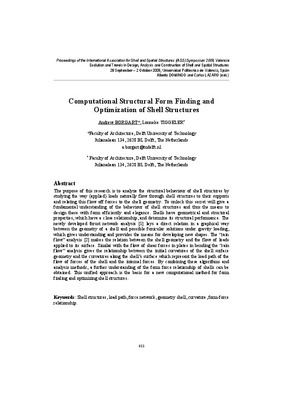JavaScript is disabled for your browser. Some features of this site may not work without it.
Buscar en RiuNet
Listar
Mi cuenta
Estadísticas
Ayuda RiuNet
Admin. UPV
Computational Structural Form Finding and Optimization of Shell Structures
Mostrar el registro sencillo del ítem
Ficheros en el ítem
| dc.contributor.author | BORGART, Andrew
|
|
| dc.contributor.author | TIGGELER, Lonneke
|
|
| dc.contributor.editor | Domingo Cabo, Alberto
|
es_ES |
| dc.contributor.editor | Lázaro Fernández, Carlos Manuel
|
es_ES |
| dc.date.accessioned | 2010-01-14T11:29:34Z | |
| dc.date.available | 2010-01-14T11:29:34Z | |
| dc.date.issued | 2010-01-14T11:29:34Z | |
| dc.identifier.isbn | 978-84-8363-461-5 | |
| dc.identifier.uri | http://hdl.handle.net/10251/6866 | |
| dc.description | p. 611-617 | en_EN |
| dc.description.abstract | The purpose of this research is to analyze the structural behaviour of shell structures by studying the way (applied) loads naturally flow through shell structures to their supports and relating this flow off forces to the shell geometry. To unlock this secret will give a fundamental understanding of the behaviour of shell structures and thus the means to design these with form efficiently and elegance. Shells have geometrical and structural properties, which have a close relationship, and determine its structural performance. The newly developed thrust network analysis [1] lays a direct relation in a graphical way between the geometry of a shell and possible funicular solutions under gravity loading, which gives understanding and provides the means for developing new shapes. The ¿rain flow¿ analysis [2] makes the relation between the shell geometry and the flow of loads applied to its surface. Similar with the flow of shear forces in plates in bending the ¿rain flow¿ analysis gives the relationship between the initial curvatures of the shell surface geometry and the curvatures along the shell¿s surface which represent the load path of the flow of forces of the shell and the internal forces. By combining these algorithms and analysis methods, a further understanding of the form force relationship of shells can be obtained. This unified approach is the basis for a new computational method for form finding and optimizing shell structures. | en_EN |
| dc.language | Inglés | en_EN |
| dc.publisher | Editorial Universitat Politècnica de València | es_ES |
| dc.relation.ispartof | Symposium of the International Association for Shell and Spatial Structures (50th. 2009. Valencia). Evolution and Trends in Design, Analysis and Construction of Shell and Spatial Structures : Proceedings | en_EN |
| dc.rights | Reserva de todos los derechos | en_EN |
| dc.subject | Shell structures | en_EN |
| dc.subject | Load path | en_EN |
| dc.subject | Force network | en_EN |
| dc.subject | Geometry shell | en_EN |
| dc.subject | Curvature | en_EN |
| dc.subject | Form-force relationship | en_EN |
| dc.title | Computational Structural Form Finding and Optimization of Shell Structures | en_EN |
| dc.type | Comunicación en congreso | en_EN |
| dc.rights.accessRights | Abierto | es_ES |
| dc.description.bibliographicCitation | Borgart, A.; Tiggeler, L. (2010). Computational Structural Form Finding and Optimization of Shell Structures. Editorial Universitat Politècnica de València. http://hdl.handle.net/10251/6866 | es_ES |
| dc.relation.conferencename | Symposium of the International Association for Shell and Spatial Structures | es_ES |
| dc.relation.conferencedate | 2009 | es_ES |
| dc.relation.conferenceplace | Valencia | es_ES |






